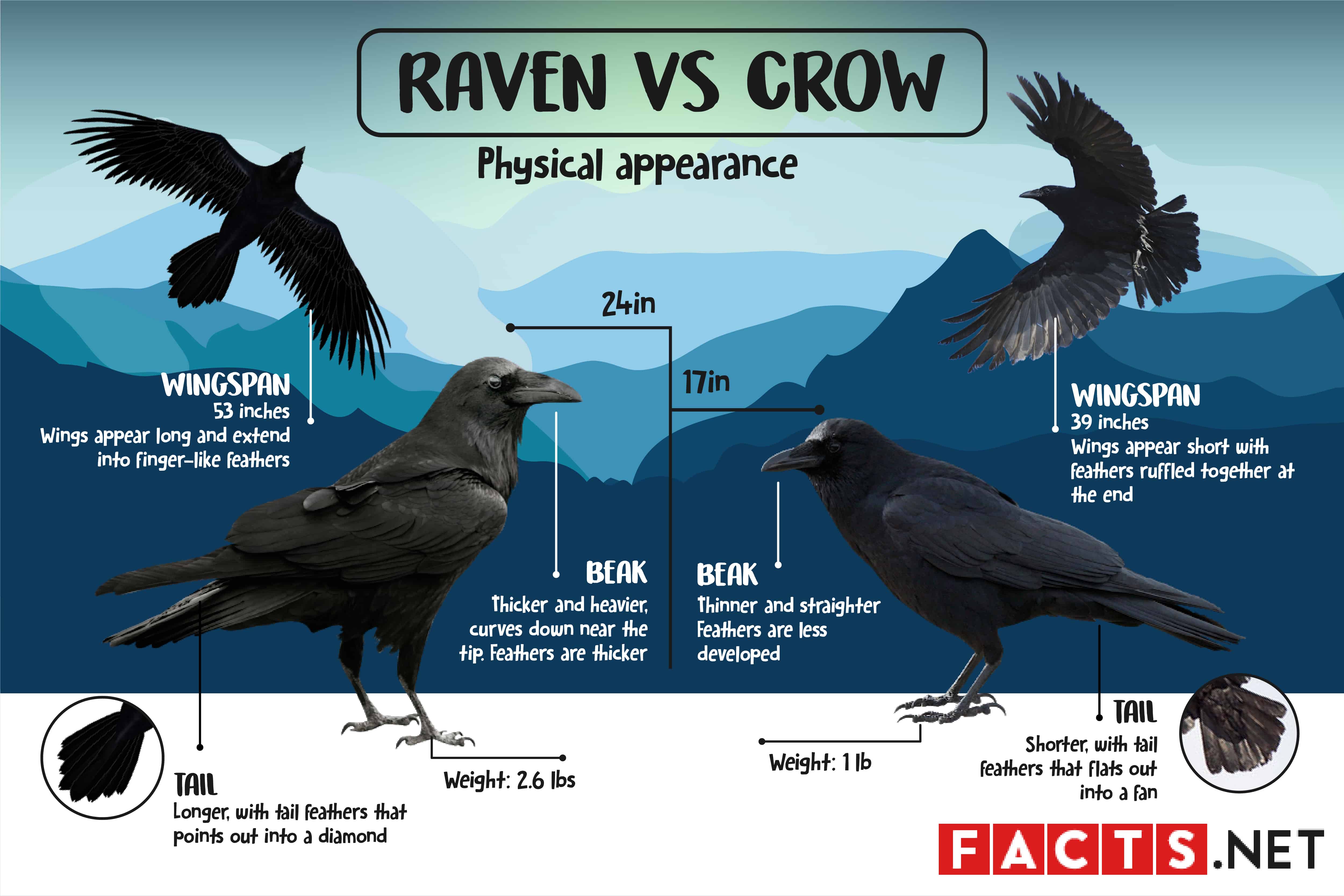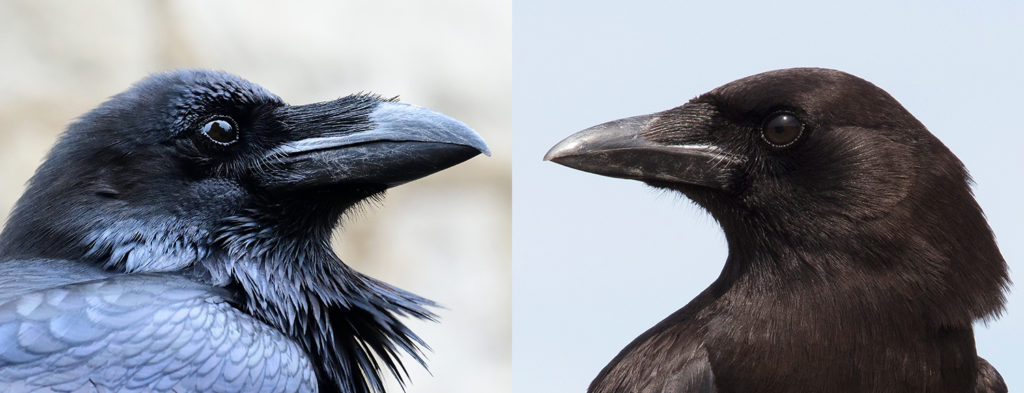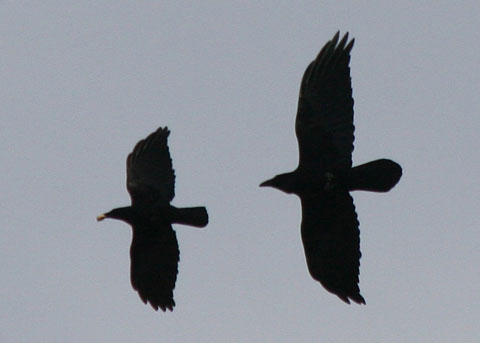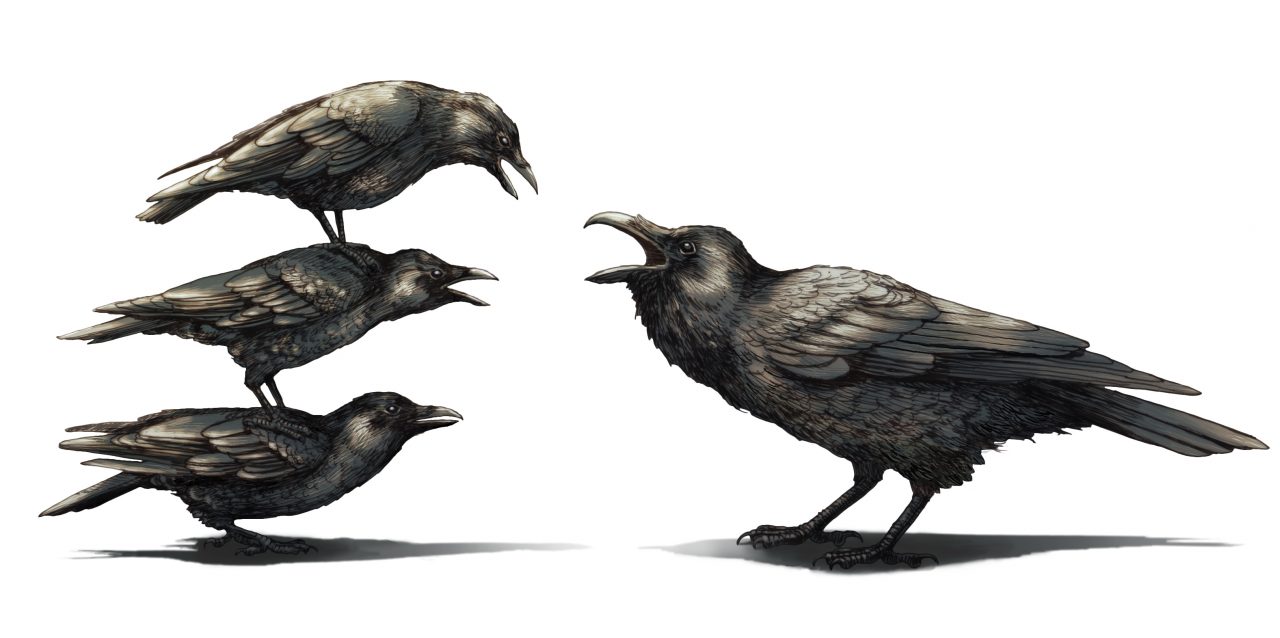
For most birdwatchers, distinguishing a raven from a crow is as easy as telling a peacock from a parrot. To most of us, however, it is easy to mix up the two black birds. At first glance, you’ll think that these birds are the same kind.
Common Ravens and American Crows are actually related. They come from the same family, Corvidae. The Common Raven’s scientific name is Corvus corax while the American Crow’s is Corvus brachyrhynchus. They have the same shape with the same black feathers. It doesn’t help that ravens and crows’ habitats overlap too as both populate North America in large numbers.
Despite these similarities, there are still distinct characteristics that can help us differentiate the two birds. Read on to find out how to tell a raven vs. a crow.
Raven vs. Crow: Physical Appearance

High in the sky, ravens and crows look the same. A black raven can easily be mistaken for a black crow. If we keep our eyes peeled, however, we’ll be able to tell the small yet sure differences between ravens and crows.
Ravens and crows have different sizes.
One principal difference between a raven and a crow is that one is larger than the other. The length of a Common Raven is usually 24 inches. An American Crow is around seven to eight inches smaller with a total length of roughly 17 inches.
Because of their different sizes, a raven naturally weighs heavier than a crow. A raven usually weighs up to 2.6 lbs while a crow is much lighter at 1 lb.

They have different beaks.
The beak of a raven is thicker and looks heavier than a crow’s. A raven’s beak curves down near the tip. Meanwhile, a crow’s beak is thinner and straighter. Feathers surround both of their beaks, but a raven’s feathers are much thicker and appear “shaggier.” The feathers surrounding a crow’s beard are less developed and look trim.

Their wingspans vary from one another.
A Common Raven’s wings can stretch out to as long as 53 inches. When we look at them in flight, we can easily see how the tips of their wings open into what look like long “fingers.” On the other hand, an American Crow’s wings are much smaller. From tip to tip, their wings usually measure 39 inches.
The next time you see a black bird in the sky, try paying closer attention to its wings. If its wings appear long and extend into individual finger-like feathers, then you’ve chanced upon a raven. If its wings seem short with feathers ruffled together at the end, then you’re looking at a crow.

Ravens and crows have different tails.
The shapes of their tails are also some of the easiest visual clues in determining a raven from a crow. A common raven’s tail is longer, with tail feathers that form a diamond or V-shape. This is because the tail feathers of a raven elongate in the middle, creating a pointy shape. In contrast, an American crow’s tail is shorter, with tail feathers that fan out in a curved shape during flight. In short, a common raven’s tail points out into a diamond while an American crow’s tail flats out into a fan.

Raven vs. Crow: Call sounds
People often ask, “Can ravens talk?” or “Can crows talk?” Well, the answer to that is that they call. This, too, is another way that we can tell a raven vs. a crow: a raven’s call sounds different from a crow’s call. So, if you’re trying to tell a raven from a crow, you’ll have to use your ears and listen closely.
A raven call is low-pitched while a crow call is high-pitched. To put it simply, crows caw while ravens croak. You’ll probably be more familiar with how crows call because most horror films use their “caw-caw” sounds as background music to set a scary scene’s mood. Still, a raven call is just as interesting and will help you determine one black bird from the other.
Raven vs. Crow: Diet
When it comes to food, ravens and crows are both omnivorous scavengers. This means that they eat both plants and animals. However, as scavengers, they mostly eat dead animals. While their classification is the same, their tastes still vary.
A raven mostly feeds on small animals, such as insects, mice, and lizards. A raven might also hunt smaller birds. You can also find ravens eating garbage in urban areas. Meanwhile, a crow will most likely feast on seeds, fruits, nuts, and worms. However, they too will take advantage of opportunities such as abandoned nests to steal eggs or young birds to eat.

Raven vs. Crow: Behavior
If you still find it difficult to tell a raven vs. a crow, then perhaps it might help to observe something else. Like humans, these black birds have distinct personalities too. If their physical appearance, call sounds, and diet don’t do the trick, why not try paying attention to how they behave?
Ravens and crows walk and fly differently.
What some people might not know about ravens and crows is that they have different manners of walking. The next time you find yourself in a park where black birds often fly over or idle by, pay close attention to their walk. If it walks like any other bird, then it’s an American Crow. If it walks and struts with two-footed hops, then you’ve found an American Raven.
This is a fun difference to watch out for that anyone can easily spot, so keep this in mind when you chance upon one of these black birds on the ground!
If the blackbird flies away before you can check their walk (or hop), then don’t worry. A raven flying is also different from a crow flying. In flight, ravens soar and glide through the air. You’ll hardly notice them flapping their wings. Meanwhile, crows frequently flap their wings while flying. This makes them look more energetic than ravens.
While they are both intelligent, their sociability differs.
What most people probably know about ravens and crows is how smart they are. Both ravens and crows have displayed clever problem-solving skills. This manifests in how they scavenge for food. When ravens and crows chance upon leftovers in sealed containers, they can open them after a few tries. To eat nuts they found, these black birds, especially crows, throw them on the ground to crack them open. Researchers have even observed some crows using small tools as well.
Ravens and crows are so smart that they can recognize human faces. This is probably why many people often ask, “Can I have a pet crow?” or “How can I befriend a crow?” It might be possible because of how American crows have excellent memories, but a word of warning: both ravens and crows are naturally distrustful of humans. American Crows might be more open to humans, but Common Ravens will most likely reject any attempts at friendship.
Of course, you shouldn’t take this personally. Even among themselves, Common Ravens often travel alone or just in pairs while American Crows flock into groups. They are much more sociable birds than Common Ravens. If you find a group of black birds huddled together, you are most likely observing crows.
Why do you think a group of crows is called a “murder of crows”? We all know that there is power in numbers, and these black birds think alike. American Crows are known to gang up on other predators. Sometimes, a murder of crows will mob a lonesome raven to ward them off from stealing eggs or baby birds from their nests. If you ever chance upon a black bird stand-off, then you can easily tell the crow from the raven by their numbers.

Raven vs. Crow: Habitat
The habitats of ravens and crows do overlap. They occupy North America in great numbers. However, there are some notable differences in the areas that they favor. Common Ravens are much more inclined to less populated areas. A raven’s habitat ranges from grasslands to beaches to forests to deserts. If you live in a rural area, where it is a lot less populated, then you’ll most likely catch a raven flying or perched on a tree every day. You can also find ravens in Central America, Europe, and Asia.

If you live in a crowded city or other urban areas, then you’ll most likely find a murder of crows instead. Crows are much more adaptable than ravens. They don’t shy away from populated areas. As long as there are trees around, then crows will have no problem surviving there. Crows, however, don’t favor deserts as much as ravens do. This is because deserts don’t have any trees for crows to nest on. American Crows will often avoid large, thick forests where daunting predators can attack them. You can easily find crows in some areas of Canada and throughout the United States.

Raven vs. Crow: Symbolism and mythology
A lot of people believe in superstitions about ravens and crows. A common belief is that they bring bad luck, just because of their midnight black color. This might also be because of how films often associate these black birds with witches and bad omens. However, when you ask someone, “What does it mean when you see a raven or crow?” not everyone will have the same answer. This is another difference between the raven and the crow that is tied to our social cultures.
Ravens appear in different mythologies.
In some Native American cultures, they view ravens as mischievous birds or tricksters. Some legends even portray a raven as a stealer of souls because of how they believe ravens act as messengers between the living and the dead. However, some tribes also revere the raven. In Washington, Alaska, and Oregon, you will even find totem poles that depict the Native American legends of these ravens.
In Norse mythology, believers associate the raven with Odin, the ruler of Asgard. As his messengers, two ravens named Huginn and Muninn fly around the world to collect intel and whisper it all into Odin’s ear. This is why Odin is called the “Raven God.” In many depictions, two ravens rest on Odin’s shoulders or his throne to emphasize the significance of these black birds’ roles in his legends.

Crows also star in their own share of legends.
In Irish mythology, crows symbolize war and death. This is like Indian Mythology, where the Indian epic, Mahabharata, associates crows as the messengers of death. They believe crows have the foresight and therefore often relay bad news to humans. In an Indian superstition, being visited by a crow at your home means an unwanted guest or visitor will arrive soon.
In contrast, Cornish folklore views the crow as an otherworldly or divine creature that warrants the utmost respect. This is like how Greek mythology reveres crows. Apollo, the Greek god of the Sun and archery, favors crows as his messengers. In one Greek tale, they say Apollo originally owned a white crow, one that he bid to watch over his lover, Coronis. However, while Apollo was away, Coronis fell in love with another, and the white crow reported this affair to Apollo. Overcome with rage and betrayal, Apollo struck a curse on the bird, turning its white feathers into a charred black.

At first, it might not be easy to tell a raven vs. a crow, but with these revealed differences, it can only get easier. Next time you’re in the park or out in the street and you notice a blackbird, watch, listen, and observe. That way, you’ll surely be able to provide plenty of answers to the question, “What’s the difference?”
Was this page helpful?
Our commitment to delivering trustworthy and engaging content is at the heart of what we do. Each fact on our site is contributed by real users like you, bringing a wealth of diverse insights and information. To ensure the highest standards of accuracy and reliability, our dedicated editors meticulously review each submission. This process guarantees that the facts we share are not only fascinating but also credible. Trust in our commitment to quality and authenticity as you explore and learn with us.


